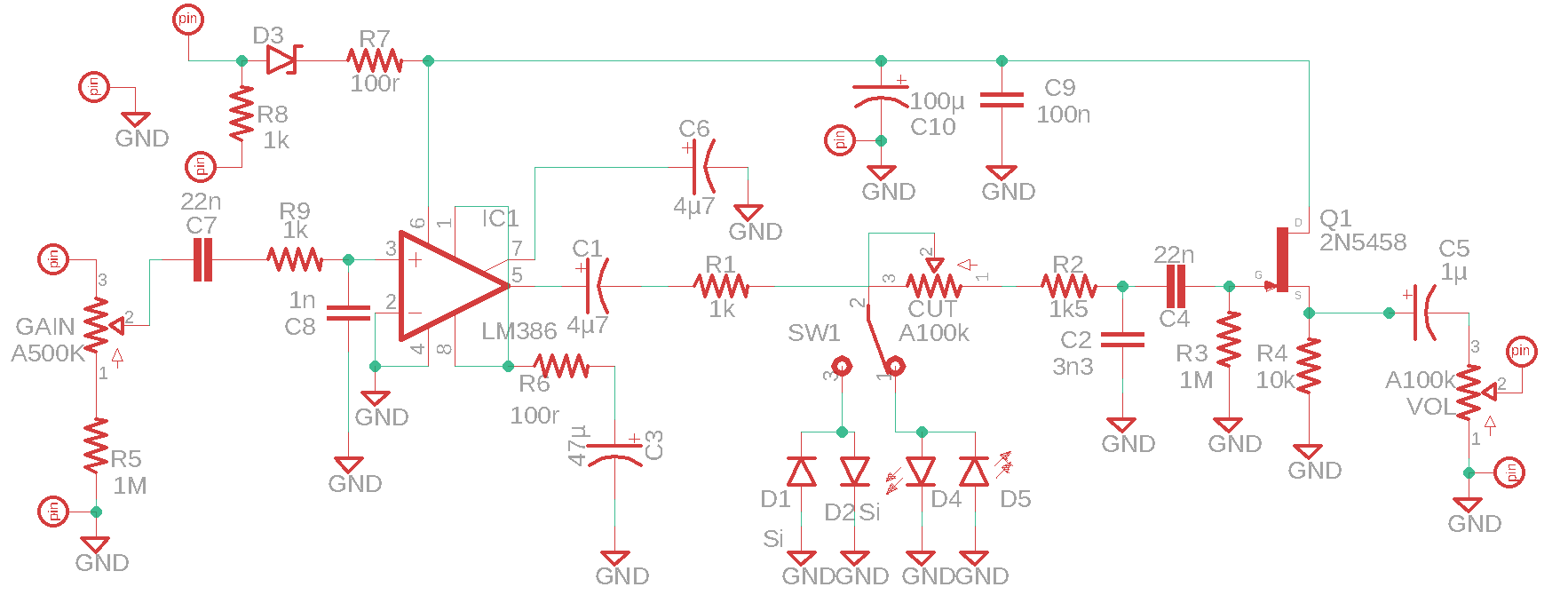This is my second entry in the End of Days Fuzz Challenge! The idea was to build a circuit similar to the Proco Rat replacing the LM308 with the LM386. The LM308 is a single op-amp the LM386 is an audio amplifier. The chips are similar but also very different.
LM386
The LM386 is similar to an op-amp but it’s inputs are biased. They don’t need an additional bias voltage. It also doesn’t need a feedback resistor. It has a great distortion sound all by itself. The LM386 has been used in many popular pedals and many DIY circuits like:
- Frantone Peach Fuzz
- Lovepedal Purple Plexi, Black Magic, and Jubilee
- Aaron Nelson Smash Drive
- RunoffGroove Ruby, Grace, Big Daddy, Little Gem
- Earth Quaker Devices Acapulco Gold
- Tim Escobedo’s Ugly Face, PWM, and more
- D*A*M Sonic Titan
Here is an in-depth and technical look at the LM386 over at Electrosmash.
This chip sounds great with guitar. Use it anywhere you need an easy to use amplifier stage with a gain of 20 to 200. Driving the chip with a guitar don’t expect clean tones. Overdriving the chip provides great distorted tones.
The output of the LM386 is powerful enough to drive a speaker. The chip comes in a couple variants that will output 1/4 watt, 1/2 watt, and 1 watt of power.
Proco Rat
My idea is to build a Proco Rat like circuit and replace the LM308 with an LM386. ElectroSmash did an in-depth analysis of the Rat, read this to get an in-depth analysis of the Rat.
In short the Rat uses a single op-amp (LM308) set up with a gain of 1 to 2300. It follows with some diodes for hard clipping, and a simple tone control that cuts the highs. The output is buffered by a JFET voltage follower.
In > Amplifier > Clipping > Tone > Buffer > out
I did two versions. In the first I replaced the LM308 single op-amp with the LM386. I threw a clipping diode option on for fun.
The Baron version 1
This design faithfully follows the original Rat circuit just swapping the LM308 with the LM386 and a couple other small changes.

This version worked well but the gain control didn’t provide much range of sound. I suspect the default gain of x20 was enough to get the diodes clipping so sound didn’t change much over the range, and the max gain of 200 wasn’t too much higher and didn’t provide a big audible difference.
The Baron Version 2
Here I added a volume control on the input. This provided a wider range of gain control at the input.

This version had a wider range of gain control than the previous version.
Conclusion
This was a good exercise. The LM386 works well here. There were also some limitations that leave this circuit not quite getting the range of tones the original has. With some more experimentation you might get more out of it.
The biggest problem is the limited gain of the LM386. The Gain of 200 is pretty high but doesn’t reach the 2300! of the Rat gets. At the low end you can dial the Rat down to a gain of 1 where the LM386 has a minimum gain of 20.
I tried to mitigate this last point in my second design. With the Gain control on the input we bring the gain down below 20. The upper limit is still in place.
Would I build this? I probably won’t put this in a box. I will keep it on the back burner. It seems like it could be a a good starting point for something, in this current state it’s lacking. The LM386 amp is a great building block that can be used many places.


Leave a Reply